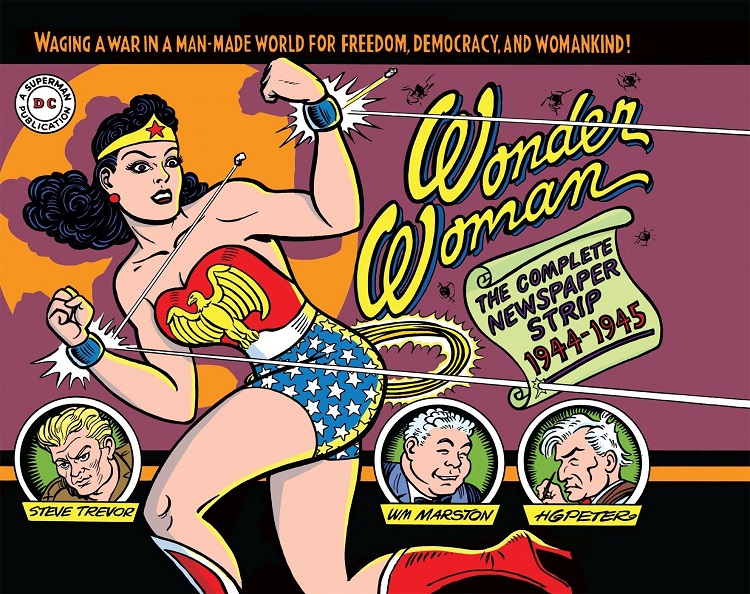
Superheroes had only been in existence for a handful of years when Wonder Woman burst on the scene in 1940 with the one-two punch of All Star Comics #8 and Sensation Comics #1. She wasn’t the first female superhero, but she was definitely the most notable and it was only a matter of time before the Amazon Princess followed her male counterparts Superman and Batman from the four-color world of comic books to the hallowed halls of the daily newspaper strip.
Thanks to the backing of the powerful Hearst publishing empire, the Wonder Woman strip reached a much larger audience than the other two members of DC’s “Trinity”, but her run was significantly shorter, lasting a little more than a year and a half – from May 1, 1944 to December 1, 1945. The strip was written and drawn by the same creative team that produced the comic book: William Moulton Marston and H.G. Peter and for the most part, adapted previously published stories from the comics to a daily format. So what we’re getting in this handsome hardcover edition (which collects the entire series) is the real deal – Wonder Woman as her creators intended her: an ideal of feminine strength, compassion, and determination, who showed fans that superwomen are every bit as powerful as the supermen and that sometimes problems could be solved with brains rather than, or in addition to, brawn.
As was the custom of the day, the collection opens up with sort of a highlight reel of Wonder Woman’s exploits, giving readers a week’s worth of “one and done” stories in which Princess Diana saves a baby from a burning building, protects a brave newspaper editor from the mob, and convinces a wealthy landowner to give a patch of land to the city in order for a playground to be erected. From there, we get a pretty lengthy origin story for both the Amazons of Paradise Island and Wonder Woman herself, who chose to forsake her immortality and enter Man’s World when the horrors of the second World War reach the peaceful shores of her homeland.
The stories are charmingly simple, reflecting a simpler time in sequential art, though certain aspects occasionally border on lunacy. Wonder Woman regularly changes from her civilian identity to her costumed one in a room full of people, “moving so fast that no one notices”. As a nurse, she tends to a sick patient by feeding her enormous amounts of candy and utilizes something known as a “Purple Healing Ray” to heal Steve Trevor’s wounds. Characters have names like Etta Candy and Erna Dollar and of course, there’s the famous Invisible Plane. It’s goofy and occasionally frustrating, but there’s a charm to it that cannot be denied.
Occasionally, the stories become overly complicated when Marston attempts to inject his education and studies on human behavior into the script. Stories involving hypnosis, shock therapy and lie detectors drag on and take unnecessary twists and turns, becoming downright laughable at times. It all feels very forced, but along with H.G. Peter’s unique artistic style, still adds a sort of odd charm to the strip. And of course, there’s the elephant in the room… it’s almost impossible to discuss early Wonder Woman stories without mentioning the bondage themes which run throughout. I’ll leave it to the historians and more educated folk to discuss the deeper meaning, along with the legacy and lifestyle of William Moulton Marston and his most famous creation and simply say this: she gets tied up, shackled, or otherwise restrained a lot and leave it at that.
Like, a lot.
Seriously… a lot.
On a final note, I should note the distinctive artwork of Harry George Peter, 65 years of age by the time the strip concluded and hand chosen by Marston himself. Peter’s Art Nouveau-influenced style of cartooning somehow manages to be grotesque and beautiful at the same time. The proportions seem a little off – everybody has kinda big heads and stubby arms – but they’re full of life and motion and his style works well with both the mythology-inspired aspects of the stories, as well as the goofier ones. His illustration background shows in his use of washes, which give depth to the artwork and makes the Wonder Woman daily strip stand out from its peers. Also noteworthy is the fantastic cover by Pete Poplaski, who also lent his skills to the covers of the Superman Sunday Comics collections.
Wonder Woman: The Complete Newspaper Strip 1944 – 1945 isn’t going to be for everyone, but there’s definitely a lot to like. Comic historians and fans of the Amazon princess will no doubt want to add this collection to their library. And as usual, IDW and the Library of American Comics have given fans the sort of quality collectible that they’ve come to be known for and continue to give respect not only to an All-American hero, but also to an art form that is every bit as American as jazz or baseball.